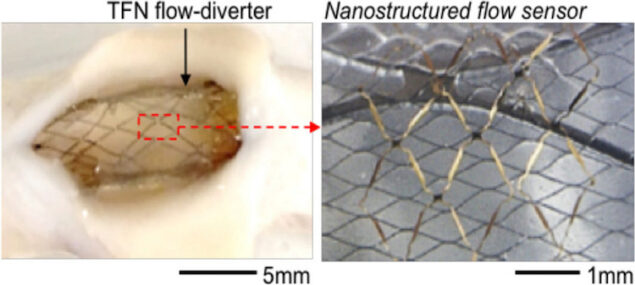
“Existing techniques to monitor intra-aneurysmal haemodynamics rely on either angiography or magnetic resonance imaging, both of which require dedicated facilities with sophisticated equipment and time-consuming, cumbersome procedures,” explains study team leader Woon-Hong Yeo of the Georgia Institute of Technology and Virginia Commonwealth University. “The soft-flow diverter system we have developed will be a game changer for the treatment of aneurysms in the future.”
Capacitive ring-type flow sensor
Yeo colleagues made their device using nanofabrication and material transfer printing techniques. The multilayered hybrid system includes a hyper-elastic thin film nitinol membrane wrapped around a stent backbone and a nanostructured capacitive ring-type flow sensor sandwiched by the polymer polyimide fully encapsulated in a soft elastomeric membrane. The soft, capacitive ring-type sensor is placed at the centre of the flow diverter, explains Yeo, which allows it to respond to varying intra-aneurysmal blood flow rates. “In fact, the capacitance sensor quantifies the change in incoming flow to the aneurysm sac from the parent blood vessel,” he says.
The device has an open mesh design and can thus be implanted in neurovascular vessels. It is extremely stretchable (it can be stretched by 500% in the radial direction) and is highly bendable (it can be bent by 180° over a curvature radius of 0.75 mm). The elastomeric membrane is also haemo-compatible (fewer blood platelets deposit on it compared to many other implantable materials).
Towards in vivo animal studies
The researchers tested out their device in vitro by implanting it in pig aorta and, thanks to fluid dynamics experiments, found that it is sensitive to blood flow rates as small as 0.032 m/s. They say that they are now planning to undertake an in vivo animal study. “Once this has been done and we have proved device safety and performance, we will then move on to human clinical trials,” says Yeo.
Reporting the work in ACS Nano 10.1021/acsnano.8b04689, the team made the stent in the flow sensor from magnesium, which is biodegradable, and confirmed that the device can be programmed to disappear in human blood and then be eliminated by the body. “We will now be studying other material compositions and device surface coatings processes to programme the functional lifetime of the sensor,” Yeo tells Physics World.
- Belle Dume, Physics World
